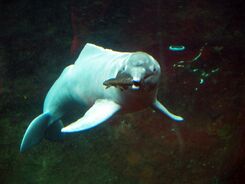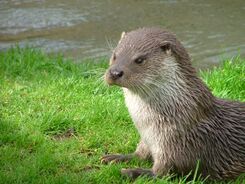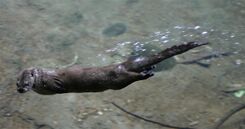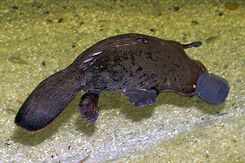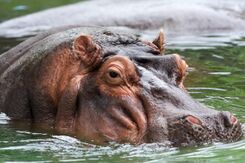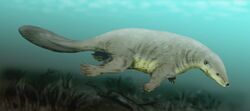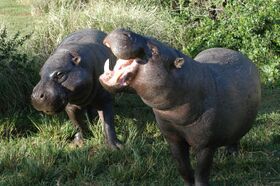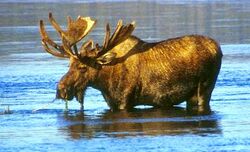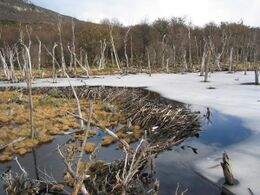Aquatic mammal
Topic: Biology
 From HandWiki - Reading time: 28 min
From HandWiki - Reading time: 28 min
Aquatic and semiaquatic mammals are a diverse group of mammals that dwell partly or entirely in bodies of water. They include the various marine mammals who dwell in oceans, as well as various freshwater species, such as the European otter. They are not a taxon and are not unified by any distinct biological grouping, but rather their dependence on and integral relation to aquatic ecosystems. The level of dependence on aquatic life varies greatly among species. Among freshwater taxa, the Amazonian manatee and river dolphins are completely aquatic and fully dependent on aquatic ecosystems. Semiaquatic freshwater taxa include the Baikal seal, which feeds underwater but rests, molts, and breeds on land; and the capybara and hippopotamus which are able to venture in and out of water in search of food.
Mammal adaptation to an aquatic lifestyle vary considerably between species. River dolphins and manatees are both fully aquatic and therefore are completely tethered to a life in the water. Seals are semiaquatic; they spend the majority of their time in the water, but need to return to land for important activities such as mating, breeding and molting. In contrast, many other aquatic mammals, such as hippopotamus, capybara, and water shrews, are much less adapted to aquatic living. Likewise, their diet ranges considerably as well, anywhere from aquatic plants and leaves to small fish and crustaceans. They play major roles in maintaining aquatic ecosystems, beavers especially.
Aquatic mammals were the target for commercial industry, leading to a sharp decline in all populations of exploited species, such as beavers. Their pelts, suited for conserving heat, were taken during the fur trade and made into coats and hats. Other aquatic mammals, such as the Indian rhinoceros, were targets for sport hunting and had a sharp population decline in the 1900s. After it was made illegal, many aquatic mammals became subject to poaching. Other than hunting, aquatic mammals can be killed as bycatch from fisheries, where they become entangled in fixed netting and drown or starve. Increased river traffic, most notably in the Yangtze river, causes collisions between fast ocean vessels and aquatic mammals, and damming of rivers may land migratory aquatic mammals in unsuitable areas or destroy habitat upstream. The industrialization of rivers led to the extinction of the Chinese river dolphin, with the last confirmed sighting in 2004.
Taxonomy and evolution
Groups
- This list covers only mammals that live in freshwater. For a list of saltwater mammals, see Marine mammal.
- Order Sirenia: sirenians
- Family Trichechidae: manatees
- Amazonian manatee (Trichechus inunguis)
- African manatee (Trichechus senegalensis)
- Family Trichechidae: manatees
- Order Cetartiodactyla: even-toed ungulates
- Suborder Whippomorpha
- Family Platanistidae
- Ganges river dolphin, or susu (Platanista gangetica)
- Indus river dolphin, or bhulan (Platanista minor)
- Family Iniidae
- Amazon river dolphin, or boto (Inia geoffrensis)
- Araguaian river dolphin (Inia araguaiaensis)
- Family Lipotidae
- Chinese river dolphin, or baiji (Lipotes vexillifer) possibly extinct
- Family Pontoporiidae
- La Plata dolphin, or franciscana (Pontoporia blainvillei)
- Family Hippopotamidae: hippopotamuses
- Hippopotamus (Hippopotamus amphibius)
- Pygmy hippopotamus (Choeropsis liberiensis)
- Family Platanistidae
- Suborder Whippomorpha
- Order Carnivora
- Family Mustelidae
- Subfamily Lutrinae
- Eurasian otter (Lutra lutra)
- Hairy-nosed otter (Lutra sumatrana)
- Spotted-necked otter (Hydrictis maculicollis)
- Smooth-coated otter (Lutrogale perspicillata)
- North American river otter (Lontra canadensis)
- Southern river otter (Lontra provocax)
- Neotropical river otter (Lontra longicaudis)
- Giant otter (Pteronura brasiliensis)
- African clawless otter (Aonyx capensis)
- Oriental small-clawed otter (Aonyx cinerea)
- Subfamily Mustelinae
- European mink (Mustela lutreola)
- American mink (Neogale vison)
- Subfamily Lutrinae
- Family Phocidae
- Genus Pusa
- Baikal seal (Pusa sibirica)
- Ladoga seal (Pusa hispida ladogensis)
- Saimaa seal (Pusa hispida saimensis)
- Genus Pusa
- Family Mustelidae
- Order Rodentia: rodents
- Suborder Hystricomorpha
- Capybara (Hydrochoerus hydrochaeris)
- Lesser capybara (Hydrochoerus isthmius)
- Coypu (Myocastor coypus)
- Family Castoridae: beavers
- North American beaver (Castor canadensis)
- Eurasian beaver (Castor fiber)
- Family Cricetidae
- Muskrat (Ondatra zibethicus)
- European water vole (Arvicola amphibius)
- Suborder Hystricomorpha
- Order Monotremata: monotremes
- Platypus (Ornithorhynchus anatinus)
- Order Afrosoricida
- Giant otter shrew (Potamogale velox)
- Order Eulipotyphla
- Family Soricidae: shrews
- Malayan water shrew (Chimarrogale hantu)
- Himalayan water shrew (Chimarrogale himalayica)
- Sunda water shrew (Chimarrogale phaeura)
- Japanese water shrew (Chimarrogale platycephala)
- Chinese water shrew (Chimarrogale styani)
- Sumatran water shrew (Chimarrogale sumatrana)
- Elegant water shrew (Nectogale elegans)
- Mediterranean water shrew (Neomys anomalus)
- Eurasian water shrew (Neomoys fodiens)
- Transcaucasian water shrew (Neomys teres)
- Glacier Bay water shrew (Sorex alaskanus)
- American water shrew (Sorex palustris)
- Pacific water shrew, or marsh shrew (Sorex bendirii)
- Family Talpidae (moles and relatives)
- Russian desman (Desmana moschata)
- Family Soricidae: shrews
- Order Didelphimorphia: opossums
- Family Didelphidae: opossums
- Big lutrine opossum (Lutreolina crassicaudata)
- Massoia's lutrine opossum (Lutreolina massoia)
- Yapok (Chironectes minimus)
- Family Didelphidae: opossums
Evolution
Mesozoic
One of the first known proto-mammals similar to modern placentals was aquatic, the Jurassic mammaliaform Castorocauda. It seems to have been adapted to water much like a beaver, with teeth different in many ways from all other docodonts, presumably due to a difference in diet. Most docodonts had teeth specialized for an omnivorous diet. The teeth of Castorocauda suggest that the animal was a piscivore, feeding on fish and small invertebrates. The first two molars had cusps in a straight row, eliminating the grinding function suggesting that they were strictly for gripping and not for chewing. This feature of three cusps in a row is similar to the ancestral condition in mammal relatives (as seen in triconodonts), but is almost certainly a derived character in Castorocauda. These first molars were also recurved in a manner adapted to hold slippery prey once grasped. These teeth are very similar to the teeth seen in mesonychians, an extinct group of semiaquatic carnivorous ungulates, and resemble, to a lesser degree, the teeth of seals.[1]
Another docodontan, the Late Jurassic Haldanodon, has been suggested to be a platypus or desman-like swimmer and burrower, being well adapted to dig and swim and occurring in a wetland environment.[2]
The tritylodontid Kayentatherium has been suggested to be semiaquatic. Unlike Castorocauda and Haldanodon, it was an herbivore, being probably beaver or capybara-like in habits.[3]
Another lineage of Mesozoic mammals, the eutriconodonts, have been suggested to be aquatic animals with mixed results. Astroconodon occurred abundantly in freshwater lacustrine deposits and its molars were originally interpreted as being similar to those of piscivorous mammals like cetaceans and pinnipeds; by extension some researchers considered the possibility that all eutriconodonts were aquatic piscivores.[4] However, Zofia Kielan-Jaworowska and other researchers have latter found that the triconodont molars of eutriconodonts were more suited for a carnassial-like shearing action than the piercing and gripping function of piscivorous mammal molars, occluding instead of interlocking, and that Astroconodon's aquatic occurrences may be of little significance when most terrestrial tetrapod fossils are found in lacustrine environments anyway.[5]
However, two other eutriconodonts, Dyskritodon and Ichthyoconodon, occur in marine deposits with virtually no dental erosion, implying that they died in situ and are thus truly aquatic mammals.[6] Nonetheless, Ichthyoconodon may not be aquatic, but instead a gliding mammal.[7][8] More recently, Yanoconodon and Liaoconodon have been interpreted as semiaquatic, bearing a long body and paddle-like limbs.[9]
A metatherian, the stagodontid Didelphodon, has been suggested to be aquatic, due to molar and skeleton similarities to sea otters.[10]
Cenozoic
An extinct genus, Satherium, is believed to be ancestral to South American river otters, having migrated to the New World during the Pliocene or early Pleistocene.[11] The South American continent houses the otter genus Lontra: the giant otter, the neotropical river otter, the southern river otter, and the marine otter.[12] The smooth-coated otter (Lutrogale perspicillata) of Asia may be its closest extant relative; similar behaviour, vocalizations, and skull morphology have been noted.[11]
The most popular theory of the origins of Hippopotamidae suggests that hippos and whales shared a common ancestor that branched off from other artiodactyls around 60 million years ago (mya).[13][14] This hypothesized ancestral group likely split into two branches around 54 mya.[15] One branch would evolve into cetaceans, possibly beginning about 52 mya, with the protowhale Pakicetus and other early whale ancestors collectively known as Archaeoceti, which eventually underwent aquatic adaptation into the completely aquatic cetaceans.[16] The other branch became the anthracotheres, and all branches of the anthracotheres, except that which evolved into Hippopotamidae, became extinct during the Pliocene without leaving any descendants.[14] River dolphins are thought to have relictual distributions, that is, their ancestors originally occupied marine habitats, but were then displaced from these habitats by modern dolphin lineages.[17][18] Many of the morphological similarities and adaptations to freshwater habitats arose due to convergent evolution; thus, a grouping of all river dolphins is paraphyletic. For example, Amazon river dolphins are actually more closely related to oceanic dolphins than to South Asian river dolphins.[19]

Sirenians, along with Proboscidea (elephants), group together with the extinct †Desmostylia and likely †Embrithopoda to form the Tethytheria. Tethytheria is thought to have evolved from primitive hoofed mammals ("condylarths") along the shores of the ancient Tethys Ocean. Tethytheria, combined with Hyracoidea (hyraxes), forms a clade called Paenungulata. Paenungulata and Tethytheria (especially the latter) are among the least controversial mammalian clades, with strong support from morphological and molecular interpretations. That is, elephants, hyraxes, and manatees share a common ancestry.[20] The ancestry of Sirenia is distinct from that of Cetacea and Pinnipedia, although they are thought to have evolved an aquatic lifestyle around the same time.[21]
The oldest fossil of the modern platypus dates back to about 100,000 years ago, during the Quaternary period. The extinct monotremes Teinolophos and Steropodon were once thought to be closely related to the modern platypus,[22] but more recent studies show that platypodes are more related to the modern echidnas than to these ancient forms and that at least Teinolophos was a rather different mammal lacking several speciations seen in platypodes.[23] However, the last common ancestor between platypodes and echidnas probably was aquatic, and echidnas thus secondarily became terrestrial.[24] Monotrematum sudamericanum is currently the oldest aquatic monotreme known. It has been found in Argentina , indicating monotremes were present in the supercontinent of Gondwana when the continents of South America and Australia were joined via Antarctica, or that monotremes existed along the shorelines of Antarctica in the early Cenozoic.[25]
Marine mammals
Marine mammals are aquatic mammals that rely on the ocean for their existence. They include animals such as sea lions, whales, dugongs, sea otters and polar bears. Like other aquatic mammals, they do not represent a biological grouping.[26]
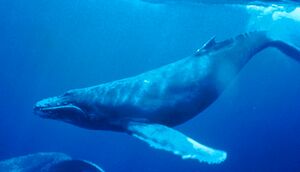
Marine mammal adaptation to an aquatic lifestyle vary considerably between species. Both cetaceans and sirenians are fully aquatic and therefore are obligate ocean dwellers. Pinnipeds are semiaquatic; they spend the majority of their time in the water, but need to return to land for important activities such as mating, breeding and molting. In contrast, both otters and the polar bear are much less adapted to aquatic living.[27] Likewise, their diet ranges considerably as well; some may eat zooplankton,[28] others may eat small fish,[29] and a few may eat other mammals.[30] While the number of marine mammals is small compared to those found on land, their roles in various ecosystems are large. They, namely sea otters and polar bears, play important roles in maintaining marine ecosystems, especially through regulation of prey populations.[31][32] Their role in maintaining ecosystems makes them of particular concern considering 25%[33] of marine mammal species are currently threatened.[34]
Marine mammals were first hunted by aboriginal peoples for food and other resources.[35] They were also the target for commercial industry, leading to a sharp decline in all populations of exploited species, such as whales and seals. Commercial hunting lead to the extinction of Steller's sea cow and the Caribbean monk seal.[36][37] After commercial hunting ended, some species, such as the gray whale and northern elephant seal,[38][39] have rebounded in numbers, however the northern elephant seal has a genetic bottleneck;[39] conversely, other species, such as the North Atlantic right whale, are critically endangered.[40] Other than hunting, marine mammals, dolphins especially, can be killed as bycatch from fisheries, where they become entangled in fixed netting and drown or starve.[41] Increased ocean traffic causes collisions between fast ocean vessels and large marine mammals.[42] Habitat degradation also threatens marine mammals and their ability to find and catch food. Noise pollution, for example, may adversely affect echolocating mammals,[43] and the ongoing effects of global warming degrades arctic environments.[44]
Adaptations
Mammals evolved on land, so all aquatic and semiaquatic mammals have brought many terrestrial adaptations into the waters. They do not breathe underwater as fish do, so their respiratory systems had to protect the body from the surrounding water; valvular nostrils and an intranarial larynx exclude water while breathing and swallowing. To navigate and detect prey in murky and turbid waters, aquatic mammals have developed a variety of sensory organs: for example, manatees have elongated and highly sensitive whiskers which are used to detect food and other vegetation directly front of them,[45] and toothed whales have evolved echolocation.[27]
Aquatic mammals also display a variety of locomotion styles. Cetaceans excel in streamlined body shape and the up-and-down movements of their flukes make them fast swimmers; the tucuxi, for example, can reach speeds of 14 miles per hour (23 km/h).[46] The considerably slower sirenians can also propel themselves with their fluke, but they can also walk on the bottom with their forelimbs.[47] The earless seals (Phocidae) swim by moving their hind-flippers and lower body from side to side, while their fore-flippers are mainly used for steering.[27] They are clumsy on land, and move on land by lunging, bouncing and wiggling while their fore-flippers keep them balanced;[29] when confronted with predators, they retreat to the water as freshwater phocids have no aquatic predators.[48]
Some aquatic mammals have retained four weight-bearing limbs (e.g. hippopotamuses, beavers, otters, muskrats) and can walk on land like fully terrestrial mammals. The long and thin legs of a moose limit exposure to and friction from water in contrast to hippopotamuses who keep most of their body submerged and have short and thick legs. The semiaquatic pygmy hippopotamus can walk quickly on a muddy underwater surface thanks to robust muscles and because all toes are weight-bearing. Some aquatic mammals with flippers (e.g. seals) are amphibious and regularly leave the water, sometimes for extended periods, and maneuver on land by undulating their bodies to move on land, similar to the up-and-down body motion used underwater by fully aquatic mammals (e.g. dolphins and manatees).[27]
Beavers, muskrats, otters, and capybara have fur, one of the defining mammalian features, that is long, oily, and waterproof in order to trap air to provide insulation.[49] In contrast, other aquatic mammals, such as dolphins, manatees, seals, and hippopotamuses, have lost their fur in favor of a thick and dense epidermis, and a thickened fat layer (blubber) in response to hydrodynamic requirements.[27]
Wading and bottom-feeding animals (e.g. moose and manatee) need to be heavier than water in order to keep contact with the floor or to stay submerged, surface-living animals (e.g. otters) need the opposite, and free-swimming animals living in open waters (e.g. dolphins) need to be neutrally buoyant in order to be able to swim up and down the water column. Typically, thick and dense bone is found in bottom feeders and low bone density is associated with mammals living in deep water.[27]
The shape and function of the eyes in aquatic animals are dependent on water depth and light exposure: limited light exposure results in a retina similar to that of nocturnal terrestrial mammals. Additionally, cetaceans have two areas of high ganglion cell concentration ("best-vision areas"), where other aquatic mammals (e.g. seals, manatees, otters) only have one.[27]
Among non-placental mammals, which cannot give birth to fully developed young,[50] some adjustments have been made for an aquatic lifestyle. The yapok has a backwards-facing pouch which seals off completely when the animal is underwater, while the platypus deposits its young on a burrow on land.
Ecology
Keystone species
Beaver ponds have a profound effect on the surrounding ecosystem. Their first and foremost ecological function is as a reservoir for times of drought, and prevent drying of riverbeds. In the event of a flood, beaver ponds slow down water-flow which reduces erosion on the surrounding soil.[51] Beaver dams hold sediment, which reduces turbidity and thereby improving overall water quality downstream. This supplies other animals with cleaner drinking water and prevents degradation of spawning grounds for fish.[52][53] However, the slower water speed and lack of shade from trees (that have since been cut down to construct the dam), results in the overall temperature increasing.[51] They also house predatory zooplankton which help break down detritus and control algae populations.[52]
Diet
Beavers are herbivores, and prefer the wood of quaking aspen, cottonwood, willow, alder, birch, maple and cherry trees. They also eat sedges, pondweed, and water lilies.[54] Beavers do not hibernate, but rather they store sticks and logs in a pile in their ponds, eating the underbark. The dams they build flood areas of surrounding forest, giving the beaver safe access to an important food supply, which is the leaves, buds, and inner bark of growing trees. They prefer aspen and poplar, but will also take birch, maple, willow, alder, black cherry, red oak, beech, ash, hornbeam and occasionally pine and spruce.[55] They will also eat cattails, water lilies and other aquatic vegetation, especially in the early spring.[56]
Indian rhinoceros are grazers. Their diets consist almost entirely of grasses, but they also eat leaves, branches of shrubs and trees, fruits, and submerged and floating aquatic plants. They feed in the mornings and evenings. They use their prehensile lips to grasp grass stems, bend the stem down, bite off the top, and then eat the grass. They tackle very tall grasses or saplings by walking over the plant, with legs on both sides and using the weight of their bodies to push the end of the plant down to the level of the mouth.[57]
Manatees make seasonal movements synchronized with the flood regime of the Amazon Basin. They are found in flooded forests and meadows during the flood season when food is abundant, and move to deep lakes during the dry season.[58] The Amazonian manatee has the smallest degree of rostral deflection (25° to 41°) among sirenians, an adaptation to feed closer to the water surface.[59]
A moose's diet often depends on its location, but they seem to prefer the new growths from deciduous trees with a high sugar content, such as white birch, trembling aspen and striped maple, among many others.[60] They also eat many aquatic plants such as waterlily and water milfoil.[61] To reach high branches, a moose may bend small saplings down, using its prehensile lip, mouth or body. For larger trees a moose may stand erect and walk upright on its hind legs, allowing it to reach plants 14.0 feet (4.26 m) off the ground.[62][63] Moose are excellent swimmers and are known to wade into water to eat aquatic plants. Moose are thus attracted to marshes and river banks during warmer months as both provide suitable vegetation to eat and water to bathe in. Moose have been known to dive underwater to reach plants on lake bottoms, and the complex snout may assist the moose in this type of feeding. Moose are the only deer that are capable of feeding underwater.[64]
Hippopotamuses leave the water at dusk and travel inland, sometimes up to 10 km (6 mi),[65] to graze on short grasses, their main source of food. They spend four to five hours grazing and can consume 68 kg (150 lb) of grass each night.[66] Like almost any herbivore, they consume other plants if presented with them, but their diet consists almost entirely of grass, with only minimal consumption of aquatic plants.[67] The pygmy hippopotamus emerges from the water at dusk to feed. It relies on game trails to travel through dense forest vegetation. It marks trails by vigorously waving its tail while defecating to further spread its feces. The pygmy hippo spends about six hours a day foraging for food, and they do not eat aquatic vegetation to a significant extent and rarely eat grass because it is uncommon in the thick forests they inhabit. The bulk of a pygmy hippo's diet consists of ferns, broad-leaved plants and fruits that have fallen to the forest floor. The wide variety of plants pygmy hippos have been observed eating suggests that they will eat any plants available. This diet is of higher quality than that of the common hippopotamus.[68][69]
The Amazon river dolphin has the most diverse diet among cetaceans, consisting of at least 53 species of fish. They mainly feed on croakers, cichlids, tetras, and piranhas, but they may also target freshwater crabs and river turtles.[70] South Asian river dolphins mainly eat fish (such as carp, catfish, and freshwater sharks) and invertebrates, mainly prawns.[71]
Generally, all aquatic desmans, shrews, and voles make quick dives and catch small fish and invertebrates. The giant otter shrew, for example, makes quick dives that last for seconds and grabs small crabs (usually no bigger than 2.8 inches (7 cm) across).[72] The Lutrine opossum is the most carnivorous opossum, usually consuming small birds, rodents, and invertebrates.[73] Water voles mainly eat grass and plants near the water and at times, they will also consume fruits, bulbs, twigs, buds, and roots. However, a population of water voles living in Wiltshire and Lincolnshire, England have started eating frogs' legs and discarding the bodies.[74]
Interactions with humans
Exploitation
Fur robes were blankets of sewn-together, native-tanned, beaver pelts. The pelts were called castor gras in French and "coat beaver" in English, and were soon recognized by the newly developed felt-hat making industry as particularly useful for felting. Some historians, seeking to explain the term castor gras, have assumed that coat beaver was rich in human oils from having been worn so long (much of the top-hair was worn away through usage, exposing the valuable under-wool), and that this is what made it attractive to the hatters. This seems unlikely, since grease interferes with the felting of wool, rather than enhancing it.[75] By the 1580s, beaver "wool" was the major starting material of the French felt-hatters.[76] Hat makers began to use it in England soon after, particularly after Huguenot refugees brought their skills and tastes with them from France.[77]
Sport hunting of the Indian rhinoceros became common in the late 1800s and early 1900s.[78] Indian rhinos were hunted relentlessly and persistently. Reports from the middle of the 19th century claim that some British military officers in Assam individually shot more than 200 rhinos. By 1908, the population in Kaziranga had decreased to around 12 individuals.[79] In the early 1900s, the species had declined to near extinction.[78] Poaching for rhinoceros horn became the single most important reason for the decline of the Indian rhino after conservation measures were put in place from the beginning of the 20th century, when legal hunting ended. From 1980 to 1993, 692 rhinos were poached in India. In India's Laokhowa Wildlife Sanctuary, 41 rhinos were killed in 1983, virtually the entire population of the sanctuary.[80] By the mid-1990s, poaching had rendered the species extinct there.[81] In 1950, Chitwan’s forest and grasslands extended over more than 2,600 km2 (1,000 sq mi) and were home to about 800 rhinos. When poor farmers from the mid-hills moved to the Chitwan Valley in search of arable land, the area was subsequently opened for settlement, and poaching of wildlife became rampant. The Chitwan population has repeatedly been jeopardized by poaching; in 2002 alone, poachers killed 37 animals to saw off and sell their valuable horns.[82]
Otters have been hunted for their pelts since at least the 1700s. There has been a long history of otter pelts being worn around the world. In China it was standard for the royalty to wear robes made from them. People that were financially high in status also wore them.[83] Otters have also been hunted using dogs, specifically the otterhound.[84] In modern times, TRAFFIC, a joint program of the World Wildlife Fund (WWF) and International Union for Conservation of Nature (IUCN), reported that otters are at serious risk in Southeast Asia and have disappeared from parts of their former range. This decline in populations is due to hunting to supply the demand for skins.[85]
Habitat degradation
One problem at Lake Baikal is the introduction of pollutants into the ecosystem. Pesticides such as DDT and hexachlorocyclohexane, as well as industrial waste, mainly from the Baykalsk Pulp and Paper Mill, are thought to have been the cause of several disease epidemics among Baikal seal populations.[86] The chemicals are speculated to concentrate up the food chain and weaken the Baikal seal's immune system, making them susceptible to diseases such as canine distemper and the plague, which was the cause of a serious Baikal seal epidemic that resulted in the deaths of thousands of animals in 1997 and 1999. Baikal seal pups have higher levels of DDT and PCB than known in any other population of European or Arctic earless seal.[86]
In the 1940s, beavers were brought from Canada to the island of Tierra Del Fuego in southern Chile and Argentina, for commercial fur production. However, the project failed and the beavers, ten pairs, were released into the wild. Having no natural predators in their new environment, they quickly spread throughout the island, and to other islands in the region, reaching a number of 100,000 individuals within just 50 years. They are now considered a serious invasive species in the region, due to their massive destruction of forest trees, and efforts are being made for their eradication.[87]
In some European countries, such as Belgium, France, and the Netherlands, the muskrat is considered an invasive pest, as its burrowing damages the dikes and levees on which these low-lying countries depend for protection from flooding. In those countries, it is trapped, poisoned, and hunted to attempt to keep the population down. Muskrats also eat corn and other farm and garden crops growing near water bodies.[88]
Urban and agricultural development, increased damming, and increased use of hydroelectric power in rivers in countries such as Côte d'Ivoire and Ghana are threats to the African manatee's habitat and life, and thick congestion of boats in waterways may cause them to have a deadly run-in with the vessels. However, even natural occurrences, such as droughts and tidal changes, often strand manatees in an unsuitable habitat. Some are killed accidentally by fishing trawls and nets intended for catching sharks.[89] The Amazonian manatee is at risk from pollution, accidental drowning in commercial fishing nets, and the degradation of vegetation by soil erosion resulting from deforestation.[58] Additionally, the indiscriminate release of mercury in mining activities threatens the entire aquatic ecosystem of the Amazon Basin.[58]
As China developed economically, pressure on the Chinese river dolphin grew significantly.[90] Industrial and residential waste flowed into the Yangtze. The riverbed was dredged and reinforced with concrete in many locations. Ship traffic multiplied, boats grew in size, and fishermen employed wider and more lethal nets. Noise pollution caused the nearly blind animal to collide with propellers. Stocks of the dolphin's prey declined drastically in the late 20th century, with some fish populations declining to one thousandth of their pre-industrial levels.[91] In the 1950s, the population was estimated at 6,000 animals,[92] but declined rapidly over the subsequent five decades. Only a few hundred were left by 1970. Then the number dropped down to 400 by the 1980s and then to 13 in 1997 when a full-fledged search was conducted. On 13 December 2006, the baiji was declared functionally extinct, after a 45-day search by leading experts in the field failed to find a single specimen. The last verified sighting was in 2004.[93]
As food
Moose are hunted as a game species in many of the countries where they are found. While the flesh has protein levels similar to those of other comparable red meats (e.g. beef, deer and elk), it has a low fat content, and the fat that is present consists of a higher proportion of polyunsaturated fats rather than saturated fats.[94]
Cadmium levels are high in moose liver and kidneys, with the result that consumption of these organs from moose more than one year old is prohibited in Finland.[95] Cadmium intake has been found to be elevated amongst all consumers of moose meat, though the meat was found to contribute only slightly to the daily cadmium intake. However the consumption of moose liver or kidneys significantly increased cadmium intake, with the study revealing that heavy consumers of moose organs have a relatively narrow safety margin below the levels which would probably cause adverse health effects.[96]
In the 17th century, based on a question raised by the Bishop of Quebec, the Roman Catholic Church ruled that the beaver was a fish (beaver flesh was a part of the indigenous peoples' diet, prior to the Europeans' arrival[97]) for purposes of dietary law. Therefore, the general prohibition on the consumption of meat on Fridays did not apply to beaver meat.[97] This is similar to the Church's classification of other semiaquatic rodents, such as the capybara and muskrat.[98][99]
See also
- Aquatic animal
- Marine mammal
References
- ↑ Ji, Qiang; Luo, Zhe-Xi; Yuan, Chong-Xi; Tabrum, Alan R. (2006). "A Swimming Mammaliaform from the Middle Jurassic and Ecomorphological Diversification of Early Mammals". Science 311 (5764): 1123–1127. doi:10.1126/science.1123026. PMID 16497926. Bibcode: 2006Sci...311.1123J. http://doc.rero.ch/record/13437/files/PAL_E249.pdf.
- ↑ Thomas Martin, Postcranial anatomy of Haldanodon exspectatus (Mammalia, Docodonta) from the Late Jurassic (Kimmeridgian) of Portugal and its bearing for mammalian evolution, Forschungsinstitut Senckenberg, Senckenberganlage 25, 60325 Frankfurt am Main, Germany Received October 2004; accepted for publication March 2005
- ↑ Anusuya Chinsamy-Turan, Forerunners of Mammals: Radiation • Histology • Biology, Indiana University Press, 18/11/2011
- ↑ Bob H. Slaughter, Astroconodon, the Cretaceous Triconodont, Journal of Mammalogy, Vol. 50, No. 1 (Feb., 1969), pp. 102-107
- ↑ Zofia Kielan-Jaworowska, Richard L. Cifelli, Zhe-Xi Luo (2004). "Chapter 7: Eutriconodontans". Mammals from the Age of Dinosaurs: origins, evolution, and structure. New York: Columbia University Press. pp. 216–248. ISBN:0-231-11918-6.
- ↑ Sigogneau-Russell, Denise (1995). "Two possibly aquatic triconodont mammals from the Early Cretaceous of Morocco". Acta Palaeontologica Polonica 40 (2): 149–162. https://www.app.pan.pl/archive/published/app40/app40-149.pdf.
- ↑ Meng, Jin; Hu, Yaoming; Wang, Yuanqing; Wang, Xiaolin; Li, Chuankui (2007). "Corrigendum: A Mesozoic gliding mammal from northeastern China". Nature 446 (7131): 889–893. doi:10.1038/nature05639. Bibcode: 2007Natur.446Q.102M.
- ↑ Gaetano, Leandro C.; Rougier, Guillermo W. (2011). "New materials of Argentoconodon fariasorum (Mammaliaformes, Triconodontidae) from the Jurassic of Argentina and its bearing on triconodont phylogeny". Journal of Vertebrate Paleontology 31 (4): 829–843. doi:10.1080/02724634.2011.589877. Bibcode: 2011JVPal..31..829G.
- ↑ Meng Chen, Gregory Philip Wilson, A multivariate approach to infer locomotor modes in Mesozoic mammals, Article in Paleobiology 41(02) · February 2015 doi:10.1017/pab.2014.14
- ↑ Kielan-Jaworowska, Zofia; Cifelli, Richard L.; Luo, Zhe-Xi (2004). Mammals from the Age of Dinosaurs: Origins, Evolution, and Structure. New York: Columbia University Press. pp. 441–462. ISBN 978-0-231-50927-5.
- ↑ 11.0 11.1 Koepfli, K.-P; Wayne, R.K. (December 1998). "Phylogenetic relationships of otters (Carnivora: Mustelidae) based on mitochondrial cytochrome b sequences". Journal of Zoology 246 (4): 401–416. doi:10.1111/j.1469-7998.1998.tb00172.x.
- ↑ Foster-Turley, Pat, ed (1990). "Otters: An Action Plan for their Conservation". IUCN/SSC Otter Specialist Group: Sections 2 and 12.
- ↑ Gatesy, J. (1997). "More DNA support for a Cetacea/Hippopotamidae clade: the blood-clotting protein gene gamma-fibrinogen". Molecular Biology and Evolution 14 (5): 537–543. doi:10.1093/oxfordjournals.molbev.a025790. PMID 9159931.
- ↑ 14.0 14.1 Lihoreau, Fabrice; Boisserie, Jean-Renaud; Manthi, Fredrick K.; Ducrocq, Stéphane (2015). "Hippos stem from the longest sequence of terrestrial cetartiodactyl evolution in Africa". Nature Communications 6 (6264): 6264. doi:10.1038/ncomms7264. ISSN 2041-1723. PMID 25710445. Bibcode: 2015NatCo...6E6264L.
- ↑ Ursing, B.M.; Arnason, U. (1998). "Analyses of mitochondrial genomes strongly support a hippopotamus-whale clade". Proceedings of the Royal Society 265 (1412): 2251–5. doi:10.1098/rspb.1998.0567. PMID 9881471.
- ↑ Boisserie, Jean-Renaud; Lihoreau, Fabrice; Brunet, Michel (2005). "The position of Hippopotamidae within Cetartiodactyla". Proceedings of the National Academy of Sciences 102 (5): 1537–1541. doi:10.1073/pnas.0409518102. PMID 15677331. Bibcode: 2005PNAS..102.1537B.
- ↑ Cassens, I.; Vicario, S.; Waddell, V.G.; Balchowsky, H.; Van Belle, D.; Ding, W.; Fan, C.; Mohan, R.S. et al. (2000). "Independent adaptation to riverine habitats allowed survival of ancient cetacean lineages". Proceedings of the National Academy of Sciences of the United States of America 97 (21): 11343–11347. doi:10.1073/pnas.97.21.11343. PMID 11027333. Bibcode: 2000PNAS...9711343C.
- ↑ Hamilton, H.; Caballero, S.; Collins, A. G.; Brownell, R. L. (2001). "Evolution of river dolphins". Proceedings of the Royal Society B: Biological Sciences 268 (1466): 549–556. doi:10.1098/rspb.2000.1385. PMID 11296868.
- ↑ Hrbek, T.; da Silva, V.M.F.; Dutra, N.; Gravena, W.; Martin, A.R.; Farias, I.P.; Turvey, S.T. (2014). "A New Species of River Dolphin from Brazil or: How Little Do We Know Our Biodiversity". PLoS ONE 9 (1): e83623. doi:10.1371/journal.pone.0083623. PMID 24465386. Bibcode: 2014PLoSO...983623H.
- ↑ Kellogg, Margaret E.; Burkett, Sandra; Dennis, Thomas R.; Stone, Gary; Gray, Brian A.; McGuire, Peter M.; Zori, Roberto T.; Stanyon, Roscoe (2007). "Chromosome painting in the manatee supports Afrotheria and Paenungulata". BMC Evolutionary Biology 7 (6): 6. doi:10.1186/1471-2148-7-6. PMID 17244368.
- ↑ Uhen, Mark D. (2007). "Evolution of Marine Mammals: Back to the Sea After 300 Million Years". The Anatomical Record 290 (6): 514–522. doi:10.1002/ar.20545. PMID 17516441.
- ↑ Rauhut, O.W.M.; Martin, T.; Ortiz-Jaureguizar, E.; Puerta, P. (2002). "The first Jurassic mammal from South America". Nature 416 (6877): 165–8. doi:10.1038/416165a. PMID 11894091. Bibcode: 2002Natur.416..165R.
- ↑ Rich, Thomas H.; Hopson, James A.; Gill, Pamela G.; Trusler, Peter; Rogers-Davidson, Sally; Morton, Steve; Cifelli, Richard L.; Pickering, David et al. (2016). "The mandible and dentition of the Early Cretaceous monotreme Teinolophos trusleri". Alcheringa: An Australasian Journal of Palaeontology 40 (4): 1–27. doi:10.1080/03115518.2016.1180034.
- ↑ Phillips, MJ; Bennett, TH; Lee, MS (2009). "Molecules, morphology, and ecology indicate a recent, amphibious ancestry for echidnas". Proc. Natl. Acad. Sci. U.S.A. 106 (40): 17089–94. doi:10.1073/pnas.0904649106. PMID 19805098. Bibcode: 2009PNAS..10617089P.
- ↑ Folger, Tim (1993). "A platypus in Patagonia (Ancient life - 1992)". Discover 14 (1): 66.
- ↑ Jefferson, T. A.; Webber, M. A.; Pitman, R. L. (2009). Marine Mammals of the World A Comprehensive Guide to their Identification (1st ed.). London: Academic Press. pp. 7–16. ISBN 978-0-12-383853-7. OCLC 326418543.
- ↑ 27.0 27.1 27.2 27.3 27.4 27.5 27.6 Reidenberg, Joy S. (2007). "Anatomical Adaptations of Aquatic Mammals". Anatomical Record 290 (6): 507–13. doi:10.1002/ar.20541. OCLC 255630658. PMID 17516440.
- ↑ Goldbogen, Jeremy A. (2010). "The Ultimate Mouthful: Lunge Feeding in Rorqual Whales". American Scientist 98 (2): 124. doi:10.1511/2010.83.124. https://www.americanscientist.org/issues/pub/the-ultimate-mouthful-lunge-feeding-in-rorqual-whales/.
- ↑ 29.0 29.1 Riedman, M. (1990). The Pinnipeds: Seals, Sea Lions, and Walruses. University of California Press. pp. 11–12. ISBN 978-0-520-06497-3. OCLC 19511610. https://archive.org/details/pinnipedssealsse0000ried.
- ↑ Jefferson, T. A.; Stacey, P. J.; Baird, R. W. (1991). "A review of killer whale interactions with other marine mammals: predation to co-existence". Mammal Review 21 (4): 151–180. doi:10.1111/j.1365-2907.1991.tb00291.x. https://swfsc.noaa.gov/uploadedFiles/Divisions/PRD/Publications/Jeffersonetal.1991(8).pdf.
- ↑ Estes, J. A.; Tinker, M. T.; Williams, T. M.; Doak, D. F. (1998). "Killer Whale Predation on Sea Otters Linking Oceanic and Nearshore Ecosystems". Science 282 (5388): 473–476. doi:10.1126/science.282.5388.473. ISSN 0036-8075. PMID 9774274. Bibcode: 1998Sci...282..473E.
- ↑ Stirling, Ian; Guravich, Dan (1988). Polar Bears. Ann Arbor, MI: University of Michigan Press. pp. 27–28. ISBN 978-0-472-10100-9. OCLC 757032303. https://books.google.com/books?id=ViOiGWPQRjIC&pg=PA27.
- ↑ "WWF Endangered Marine Species Guide September 2019". https://files.worldwildlife.org/wwfcmsprod/files/Publication/file/6yj122pa08_WWF_Endangered_Marine_Species_Guide__September_2019_v3_.pdf.
- ↑ Schipper, J.; Chanson, J. S.; Chiozza, F.; Cox, N. A. (2008). "The status of the world's land and marine mammals: diversity, threat, and knowledge". Science 322 (5899): 225–230. doi:10.1126/science.1165115. PMID 18845749. Bibcode: 2008Sci...322..225S.
- ↑ Berta, A; Sumich, J. L. (1999). "Exploitation and conservation". Marine Mammals: Evolutionary Biology. San Diego: Academic Press. ISBN 978-0-12-093225-2. OCLC 42467530.
- ↑ Turvey, ST; Risley, CL (22 March 2006). "Modelling the extinction of Steller's sea cow". Biol. Lett. 2 (1): 94–7. doi:10.1098/rsbl.2005.0415. PMID 17148336.
- ↑ Adam, Peter (2004). "Monachus tropicali". Mammalian Species (747): 1–9. doi:10.1644/747.
- ↑ Clifford, Frank (1994). "Gray Whale Removed From Endangered List". Los Angeles Times. http://articles.latimes.com/1994-06-16/news/mn-4742_1_gray-whale.
- ↑ 39.0 39.1 Haw, Jim; Handy, Dana (2013). "Northern Elephant Seals: Increasing Population, Decreasing Biodiversity". Scientific American. http://blogs.scientificamerican.com/expeditions/northern-elephant-seals-increasing-population-decreasing-biodiversity/. Retrieved 28 June 2016.
- ↑ Cooke, J.G. (2020). "Eubalaena glacialis". IUCN Red List of Threatened Species 2020: e.T41712A178589687. doi:10.2305/IUCN.UK.2020-2.RLTS.T41712A178589687.en. https://www.iucnredlist.org/species/41712/178589687. Retrieved 19 December 2023.
- ↑ Bruno, Díaz L. (2006). "Interactions between Mediterranean bottlenose dolphins (Tursiops truncatus) and gillnets off Sardinia, Italy". Journal of Marine Science 63 (5): 946–951. doi:10.1016/j.icesjms.2005.06.012.
- ↑ Vanderlaan, Angelia S. M.; Taggart, Christopher T. (2007). "Vessel Collisions with Whales: The Probability of Lethal Injury Based on Vessel Speed". Marine Mammal Science 23 (1): 144–156. doi:10.1111/j.1748-7692.2006.00098.x.
- ↑ Harwood, J. (2001). "Marine Mammals and their Environment in the Twenty-First Century". Journal of Mammalogy 82 (3): 630–640. doi:10.1644/1545-1542(2001)082<0630:MMATEI>2.0.CO;2.
- ↑ Simmonds, M. P.; Isaac, S. J. (2007). "The impacts of climate change on marine mammals: Early signs of significant problems". Oryx 41: 19. doi:10.1017/S0030605307001524.
- ↑ Marshall, Christopher D.; Maeda, Hiroshi; Iwata, Matsumitsu; Furuta, Masami; Asano, Shiro; Rosas, Fernando; Reep, Roger L. (2003). "Orofacial morphology and feeding behaviour of the dugong, Amazonian, West African and Antillean manatees (Mammalia: Sirenia): functional morphology of the muscular-vibrissal complex". Journal of Zoology 259 (3): 245–260. doi:10.1017/S0952836902003205. http://www.tamug.edu/marshall/Pubs_repository/Marshal_et_al_2003_Zoology.pdf.
- ↑ Edwards, Holly H.; Schnell, Gary D. (2001). "Body Length, Swimming Speed, Dive Duration, and Coloration of the Dolphin Sotalia fluviatilis (Tucuxi) in Nicaragua". Caribbean Journal of Science 37: 271–298. http://www.bio-nica.info/biblioteca/Edwards2001.pdf.
- ↑ Kingdon, Jonathan; Happold, David; Butynski, Thomas; Hoffmann, Michael; Happold, Meredith; Kalina, Jan (2013). Mammals of Africa. 1. New York: Bloomsbury Publishing. p. 211. ISBN 978-1-4081-2251-8. OCLC 822025146. https://books.google.com/books?id=B_07noCPc4kC&pg=PA211.
- ↑ Perrin 2009, p. 924.
- ↑ Glass, Mogens L.; Wood, Stephen C., eds (2009). Cardio-Respiratory Control in Vertebrates: Comparative and Evolutionary Aspects. Berlin: Springer. pp. 89–90. doi:10.1007/978-3-540-93985-6. ISBN 978-3-540-93984-9. OCLC 437346699. https://books.google.com/books?id=VzPxlKuOfSIC&Z&pg=PA89.
- ↑ Michael L. Power,Jay Schulkin. The Evolution Of The Human Placenta. pp. 68–.
- ↑ 51.0 51.1 Rossell, F.; Bozser, O.; Collen, P.; Parker, H. (2005). "Ecological impact of beavers Castor fiber and Castor canadensis and their ability to modify ecosystems". Mammal Review 35 (3–4): 248–276. doi:10.1111/j.1365-2907.2005.00067.x.
- ↑ 52.0 52.1 Błędzki, Leszek A.; Bubier, Jill; Moulton, L. A.; Kyker-Snowman, T. D. (2011). "Downstream effects of beaver ponds on the water quality of New England first‐ and second‐order streams". Ecohydrology 4 (5): 698–707. doi:10.1002/eco.163. https://www.researchgate.net/publication/230462636.
- ↑ "Turbidity: Description, Impact on Water Quality, Sources, Measures". Minnesota Pollution Control Agency. March 2008. https://www.pca.state.mn.us/sites/default/files/wq-iw3-21.pdf.
- ↑ Ringelman, James K.. "Managing Beaver to Benefit Waterfowl". United States Geological Survey. http://www.nwrc.usgs.gov/wdb/pub/wmh/13_4_7.pdf.
- ↑ Müller-Schwarze, Dietland; Sun, Lixing (2003). The Beaver: Natural History of a Wetlands Engineer. Cornell University Press. pp. 67–75. ISBN 978-0-8014-4098-4. OCLC 905649783. https://books.google.com/books?id=eqIenKko3lAC.
- ↑ Belovsky, Gary E. (1984). "Summer Diet Optimization by Beaver". The American Midland Naturalist 111 (2): 209–222. doi:10.2307/2425316. ISSN 0003-0031.
- ↑ Laurie, W. A.; Lang, E. M.; Groves, C. P. (1983). "Rhinoceros unicornis". Mammalian Species (211): 1–6. doi:10.2307/3504002. http://www.science.smith.edu/msi/pdf/i0076-3519-211-01-0001.pdf. Retrieved 23 June 2016.
- ↑ 58.0 58.1 58.2 Marmontel, M.; de Souza, D.; Kendall, S. (2016). "Trichechus inunguis". IUCN Red List of Threatened Species 2016: e.T22102A43793736. doi:10.2305/IUCN.UK.2016-2.RLTS.T22102A43793736.en. https://www.iucnredlist.org/species/22102/43793736. Retrieved 11 November 2021.
- ↑ Guterres-Pazin, Michelle G.; Marmontel, Miriam; Rosas, Fernando C. W.; Pazin, Victor F. V.; Venticinque, Eduardo M. (2014). "Feeding Ecology of the Amazonian Manatee (Trichechus inunguis) in the Mamirauá and Amanã Sustainable Development Reserves, Brazil". Aquatic Mammals 40 (2): 139–149. doi:10.1578/AM.40.2.2014.139. http://www.aquaticmammalsjournal.org/attachments/article/682/AM%2040.2%20Guterres-Pazin.pdf. Retrieved 2016-06-26.
- ↑ Howard, Janet L. (1996). "Populus tremuloides". U.S. Department of Agriculture, Forest Service, Rocky Mountain Research Station, Fire Sciences Laboratory. http://www.fs.fed.us/database/feis/plants/tree/poptre/all.html.
- ↑ Saskatchewan Environment and Resource Manager and Canadian Plains Research Center (2001). Natural Neighbours: Selected Mammals of Saskatchewan. Regina, Saskatchewan: University of Regina. p. 170. ISBN 978-0-88977-123-9. OCLC 607394660. https://books.google.com/books?id=170.
- ↑ Dalrymple, Byron (1983). North American big-game animals (1st ed.). Stoeger Publishing. p. 84. ISBN 978-08769-1142-6. OCLC 1054473. https://archive.org/details/northamericanbig0000dalr/page/84.
- ↑ Farb, Peter (1966). The Land and Wildlife of North America. California State department of Education. p. 177. ISBN 978-0809439195.
- ↑ Geist, Valerius (1998). Deer of the World: Their Evolution, Behaviour, and Ecology (1st ed.). Machaniesburg, PA: Stackpole Books. p. 237. ISBN 978-0-8117-0496-0. OCLC 37713037. https://books.google.com/books?id=bcWZX-IMEVkC&pg=PA237.
- ↑ Estes, R. (1992). The Behavior Guide to African Mammals: including hoofed mammals, carnivores, primates. San Francisco: University of California Press. pp. 222–226. ISBN 978-0-520-08085-0. OCLC 19554262. https://archive.org/details/isbn_0520080858/page/222.
- ↑ "Hippopotamus". http://www.krugerpark.co.za/africa_hippopotamus.html.
- ↑ Grey, J.; Harper, D. M. (2002). "Using Stable Isotope Analyses To Identify Allochthonous Inputs to Lake Naivasha Mediated Via the Hippopotamus Gut". Isotopes in Environmental Health Studies 38 (4): 245–250. doi:10.1080/10256010208033269. PMID 12725427.
- ↑ Eltringham, S. Keith (1999). The Hippos. London: Academic Press. ISBN 978-0-85661-131-5. OCLC 42274422.
- ↑ Zschokke, Samuel (2002). "Distorted Sex Ratio at Birth in the Captive Pygmy Hippopotamus, Hexaprotodon Liberiensis". Journal of Mammalogy 83 (3): 674–681. doi:10.1644/1545-1542(2002)083<0674:DSRABI>2.0.CO;2.
- ↑ Wilson, Don; Reeder, DeeAnn (2005). Mammal Species of the World. 2. Johns Hopkins University Press. p. 738. ISBN 978-0-8018-8221-0. OCLC 300296060. https://books.google.com/books?id=YnYED-YG0ZYC&pg=PA738.
- ↑ "Ganges River dolphin". World Wildlife Fund. http://wwf.panda.org/what_we_do/endangered_species/cetaceans/about/river_dolphins/ganges_river_dolphin/.
- ↑ Stephenson, P.J.; Goodman, S.; Soarimalala, V. (2016). "Potamogale velox". IUCN Red List of Threatened Species 2016: e.T18095A97203526. doi:10.2305/IUCN.UK.2016-1.RLTS.T18095A97203526.en. https://www.iucnredlist.org/species/18095/97203526. Retrieved 11 November 2021.
- ↑ Regidor, Héctor A.; Gorostiague, Martín; Sühring, Silvia. "Reproduction and dental age classes of the little water opossum (Lutreolina crassicaudata) in Buenos Aires, Argentina". Revista de Biología Tropical 47 (1–2): 271–272. ISSN 0034-7744.
- ↑ "Water voles get a taste for frogs". BBC News. 30 April 2010. http://news.bbc.co.uk/1/hi/england/wiltshire/8654410.stm.
- ↑ Dolin, Eric J. (2010). Fur, Fortune, and Empire: The Epic History of the Fur Trade in America. New York: W. W. Norton and Company. p. 46. ISBN 978-0-393-06710-1. OCLC 449865266. https://books.google.com/books?id=7G-xsTzXz6sC&pg=PA46.
- ↑ Brook, Timothy (2008). Vermeer's Hat: The Seventeenth Century and the Dawn of the Global World. New York: Bloomsbury Press. p. 43. ISBN 978-1-59691-444-5. OCLC 123137094. https://books.google.com/books?id=2avtJqYc1eMC&pg=PA43.
- ↑ Wiley, I. W. (1868). The Ladies' Repository. 28. Nabu Press. p. 363. ISBN 978-1-276-66898-9. https://books.google.com/books?id=KlTQAAAAMAAJ&pg=PA363.
- ↑ 78.0 78.1 Ellis, S.; Talukdar, B. (2019). "Rhinoceros unicornis". IUCN Red List of Threatened Species 2019: e.T19496A18494149. doi:10.2305/IUCN.UK.2019-3.RLTS.T19496A18494149.en. https://www.iucnredlist.org/species/19496/18494149. Retrieved 19 December 2023.
- ↑ Laurie, W. A.; Lang, E. M.; Groves, C. P. (1983). "Rhinoceros unicornis". Mammalian Species (211): 1–6. doi:10.2307/3504002. http://www.science.smith.edu/msi/pdf/i0076-3519-211-01-0001.pdf. Retrieved 23 June 2016.
- ↑ Menon, Vivek (1996). "Under siege: Poaching and protection of Greater One-horned Rhinoceroses in India". TRAFFIC India. https://portals.iucn.org/library/efiles/edocs/Traf-025.pdf.[yes|permanent dead link|dead link}}]
- ↑ Foose, T.; van Strien, N. (1997). Asian Rhinos – Status Survey and Conservation Action Plan. International Union for Conservation of Nature. ISBN 978-2-8317-0336-7. OCLC 36838946. http://www.rhinoresourcecenter.com/ref_files/1175857641.pdf.
- ↑ Adhikari, T. R. (2002). "The Curse of Success". Habitat Himalaya – A Resources Himalaya Factfile. http://www.sosrhino.org/news/Updatepoaching.pdf.
- ↑ Ingrams, F. C. (1924). "Furs and the Fur Trade". Journal of the Royal Society of Arts 72 (3739): 593–605.
- ↑ "Breed history". The Otterhound Club of America. http://www.otterhound.org/Breed_History.html.
- ↑ "Otters feel the heat in Southeast Asia". TRAFFIC. 2009. http://www.traffic.org/home/2009/12/9/otters-feel-the-heat-in-southeast-asia.html.
- ↑ 86.0 86.1 Iwata, Hisato; Watanabe, Mafumi; Okajima, Yuka; Tanabe, Shinsuke; Amano, Masao; Miyazaki, Nobuyuki; Petrov, Evgeny A. (2004). "Toxicokinetics of PCDD, PCDF, and Coplanar PCB Congeners in Baikal Seals, Pusa sibirica: Age-Related Accumulation, Maternal Transfer, and Hepatic Sequestration". Environmental Science and Technology 38 (13): 3505–3513. doi:10.1021/es035461+. PMID 15296299. Bibcode: 2004EnST...38.3505I.
- ↑ Loewy, Matías (2015). "North American Beaver Invasion Occupies Forests and Steppes in Southern Chile and Argentina". Scientific American. http://www.scientificamerican.com/article/north-american-beaver-invasion-occupies-forests-and-steppes-in-southern-chile-and-argentina/. Retrieved 25 June 2016.
- ↑ Skyrienė, Gintarė; Paulauskas, Algimantas (2012). "Distribution of invasive muskrats (Ondatra zibethicus) and impact on ecosystem". Ekologija 58 (3): 357–367. doi:10.6001/ekologija.v58i3.2532. http://www.gamtostyrimai.lt/uploads/publications/docs/352_724341bcbb85e7b0a7dbb27c492b5bad.pdf.
- ↑ Keith Diagne, L. (2015). "Trichechus senegalensis". IUCN Red List of Threatened Species 2015: e.T22104A97168578. doi:10.2305/IUCN.UK.2015-4.RLTS.T22104A81904980.en. https://www.iucnredlist.org/species/22104/97168578. Retrieved 19 December 2023.{{cite iucn}}: error: |doi= / |page= mismatch (help)
- ↑ Klinowska, Margaret; Cooke, Justin (1991). Dolphins, Porpoises, and Whales of the World: the IUCN Red Data Book. pp. 41–46. https://portals.iucn.org/library/sites/library/files/documents/RD-1991-001.pdf.
- ↑ Black, Richard (27 June 2006). "Last Chance for China's Dolphin". Archived from the original on 6 July 2006. Retrieved 27 June 2006.
- ↑ "Rescue Plan Prepared for Yangtze River Dolphins". 11 July 2002. Retrieved 18 December 2006.
- ↑ Turvey, S.T.; Pitman, R.L.; Taylor, B.L.; Barlow, J.; Akamatsu, T.; Barrett, L.A.; Zhao, X.; Reeves, R.R. et al. (2007). "First human-caused extinction of a cetacean species?". Biology Letters 3 (5): 537–540. doi:10.1098/rsbl.2007.0292. PMID 17686754.
- ↑ "Moose, meat, raw (Alaska Native)". Self Nutrition Data. http://www.nutritiondata.com/facts-C00001-01c22al.html.
- ↑ "All-clear for Finnish foods". Food Quality News. 2003. http://www.foodqualitynews.com/Food-Alerts/All-clear-for-Finnish-foods.
- ↑ Vahteristo, L.; Lyytikäinen, T.; Venäläinen, E. R.; Eskola, M.; Lindfors, E.; Pohjanvirta, R.; Maijala, R. (2003). "Cadmium intake of moose hunters in Finland from consumption of moose meat, liver and kidney". Food Additives and Contamination 20 (5): 453–463. doi:10.1080/0265203031000094636. PMID 12775464.
- ↑ 97.0 97.1 Lacoursière, Jacques (1995) (in fr). Une histoire du Québec. Septentrion. ISBN 978-2-89448-050-2. OCLC 678751406. https://archive.org/details/histoirepopulair0000laco.
- ↑ "In Days Before Easter, Venezuelans Tuck Into Rodent-Related Delicacy". The New York Sun. 24 March 2005. http://www.nysun.com/foreign/in-days-before-easter-venezuelans-tuck-into/11063/.
- ↑ Holusha, John (April 1988). "Where the Muskrat Is a Delicacy for Lent". The New York Times. https://www.nytimes.com/1988/04/01/us/wyandotte-journal-where-the-muskrat-is-a-delicacy-for-lent.html.
Further reading
- Perrin, W. F.; Wursig, B.; Thewissen, J. G. M. (2009). Encyclopedia of Marine Mammals. San Diego: Academic Press. ISBN 978-0-0809-1993-5. https://books.google.com/books?id=2rkHQpToi9sC.
 |
 KSF
KSF


